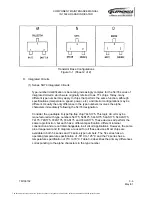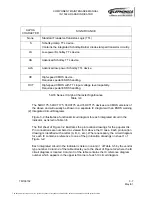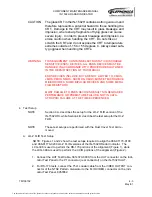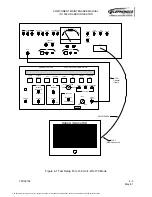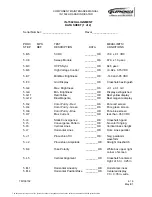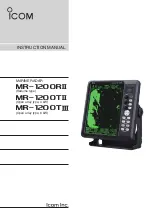
COMPONENT MAINTENANCE MANUAL
IN 1502H RADAR INDICATOR
TM109102
4-3
May/01
CAUTION
The glass CRT in the IN-1502H contains a strong vacuum and
therefore represents a potential hazard to those handling the
CRT. Damage to the CRT may result in glass breakage and
implosion, where sharp fragments of flying glass can cause
severe injury. In order to prevent breakage and implosion, ex-
ercise caution when handling the CRT. Do not strike or
scratch the CRT and do not expose the CRT to temperature
extremes outside of -15 to + 55 degrees C. Always wear safe-
ty goggles when handling the CRTs.
WARNING
THIS EQUIPMENT CONTAINS ELECTROSTATIC DISCHARGE
SENSITIVE (ESDS) DEVICES. ALL ESDS DEVICES MUST BE
HANDLED IN ACCORDANCE WITH PROCEDURES OUTLINED
IN THE REPAIR SECTION OF THIS MANUAL.
ESDS DEVICES INCLUDE, BUT ARE NOT LIMITED TO, CMOS,
JMOS, PMOS, NMOS, SOCMOS, HMOS, MOSFET MICROWAVE
MIXER DIODES, SOME BIPOLAR DEVICES AND SOME METAL
FILM RESISTORS.
MOST DAMAGE TO ESDS DEVICES RESULTS IN DEGRADED
PERFOMANCE OR PREMATURE FAILURE, NOT IN CATA-
STROPHIC FAILURE AT THE TIME EXPERIENCED.
4. Test Setup
NOTE
Section 4.A. describes the setup for the LO-Z FLIR version of the
IN-1502H RI, while Section 4.B. describes the test setup for the HI-Z
FLIR.
NOTE
These test setups are performed with the Dust Cover Test Aid re-
moved.
A. LO-Z FLIR Test Setup
NOTE: Figures 1 and 2 show the test setups required to align the 066-01170-0100
and 066-01170-0200 LO-Z FLIR versions of the IN-1502H Radar Indicator. The
LCG-396 is used to perform the RS-170 portions of the alignment (Figure 1), while
the LCG-399A is used to perform the CCIR portions of the alignment (Figure 2).
1. Connect the UUT Test Cable, 3614370-0000, from the UUT connector on the Indi-
cator Test Panel to the P1 connector (rear connector) on the IN-1502H UUT.
2. For RS-170 tests, connect the 75
Ω
coaxial cable from the VIDEO OUTPUT con-
nector of the NTSC Pattern Generator to the FLIR VIDEO connector on the Indi-
cator Test Panel, 8050362.
The document reference is online, please check the correspondence between the online documentation and the printed version.


